
Traditional B2B sales strategies like cold calls and mass emails are no longer effective. Today’s buyers do independent research, seek peer validation, and expect tailored, value-driven engagement. To succeed in 2025, your sales strategy must be data-informed, automated, and genuinely customer-centric.
Most B2B sales efforts fail because they prioritize internal processes over the buyer’s experience. Outreach becomes a volume game, not a value game. This guide offers 12 practical frameworks and tools to help modern teams sell the way buyers actually buy.
What is a B2B Sales Strategy? (And Why Most Fail Today)
A B2B sales strategy is a structured, data-driven plan that outlines how your company targets, engages, and converts business customers. It defines your Ideal Customer Profile (ICP), maps out the most effective sales channels (like LinkedIn, email, or phone), and establishes clear, measurable goals for revenue growth.
Unlike B2C, where decisions are simpler and made by individuals, B2B sales target complex, multi-stakeholder problems. That makes a well-crafted strategy not optional but critical for sustainable growth.
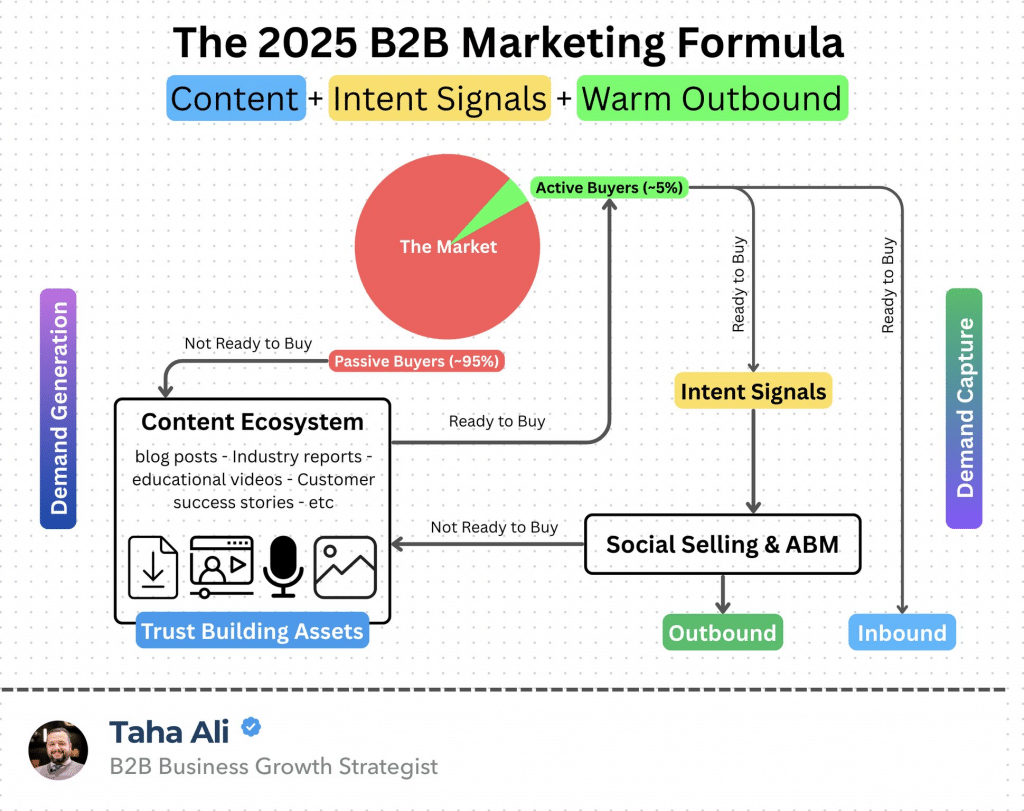
Understanding Today’s B2B Buyer
B2B buying today is nonlinear, complex, and multi-threaded. Decisions are rarely made by a single person. Most decisions are made by committees of 6 to 10 decision-makers, each with unique concerns. And before speaking to sales, these buyers complete about 70% of their research online.

This shift makes your digital presence your first sales touchpoint. Buyers search for solutions to specific problems and engage with educational content. LinkedIn, in particular, has become a go-to platform where decision-makers vet vendors and gather insights. Your strategy must meet buyers in these spaces with content that builds credibility and answers real questions.
Today’s B2B buyers have instant access to product specifications, peer reviews, pricing comparisons, and competitor alternatives. In this era of information parity, sellers are no longer gatekeepers—they’re strategic advisors. The most successful sales conversations don’t start with a scripted discovery call. They start by delivering insight, relevance, and value upfront. Trust is built not by extracting information, but by offering it.
The 3 Types of B2B Sales Growth Strategies
The growth model you choose sets the tone for your entire sales operation: how teams are structured, how leads are generated, and how your business scales. Below are the three most effective B2B growth strategies used in 2025.
1. Product-Led Growth (PLG)
In a PLG model, the product itself drives acquisition and expansion. Free trials or freemium options let users experience value firsthand. If the product solves a problem quickly, users naturally become advocates.
PLG thrives on “land and expand.” It starts with one user solving a specific problem. Once they hit the “aha!” moment, the product spreads internally. Sales teams then engage Product-Qualified Leads (PQLs)—users already invested in the product—to scale adoption across the organization.

When it works best: Tools with low friction, fast time-to-value, and easy onboarding. Examples: Slack, Dropbox, Calendly.
2. Sales-Led Growth (SLG)
SLG puts sales at the center. Reps lead prospecting, nurturing, and closing—ideal for high-ticket or complex products that need hands-on guidance, custom demos, and long sales cycles.

When it works best: Enterprise SaaS, heavy industrial equipment, consulting services.

3. Hybrid/Account-Based Selling
Hybrid strategies combine product-led and sales-led elements. Often used in Account-Based Marketing (ABM), sales and marketing align to target key accounts with personalized campaigns. The product may draw users in, while sales focuses on expanding within large, strategic accounts.
When it works best: Companies with both self-serve and enterprise tiers, or when targeting large organizations with complex needs.
No matter which B2B growth strategy you choose—product-led, sales-led, or hybrid—execution at scale is where most teams struggle. That’s where tools like Linked Helper come in.
Linked Helper is a LinkedIn automation and outreach platform designed to streamline top-of-funnel activities like prospecting, messaging, and lead nurturing.
How Linked Helper Supports Each Model:
- PLG: Automate onboarding follow-ups, check-in sequences, and identify power users for upsell outreach.
- SLG: Automate the full LinkedIn outbound process—from lead collecting to multi-touch follow-ups, so reps focus on selling.
- Hybrid (ABM): Run hyper-personalized LinkedIn campaigns for key accounts with consistent messaging and multi-touch engagement
How to Build Your B2B Sales Strategy From Scratch
Building a robust B2B sales strategy doesn’t have to be an academic exercise filled with abstract theories. Instead, think of it as creating a detailed blueprint for your revenue engine.Without it, sales efforts become chaotic, messaging is inconsistent, and results are impossible to forecast. With the right strategy, every action your team takes becomes aligned, measurable, and optimized for growth.
Here’s a step-by-step framework to build your strategy from the ground up, using today’s best practices and automation tools like Linked Helper to drive execution at scale.
Step 1: Define Your ICP and Key Segments
Your ICP is more than “SaaS companies with 50+ employees.” A strong profile includes:
| Dimension | Key Attributes | Guiding Questions for Your Business |
| Firmographic | Industry, company size, revenue, geographic location. | Which markets yield high LTV and retention? |
| Technographic | Tools, CRMs, platforms they use | What key integrations would our product need to fit into their existing workflow? |
| Behavioral | Triggers, pain points, goals | What urgent problem do we solve better than anyone? |
| Economic Potential | CAC vs. LTV, upsell potential | Is this customer worth acquiring and growing over time? |
Why it matters: Without a clear ICP, your outreach is random. With it, every message is tailored and relevant.
Linked Helper Tip: Use LinkedIn filters + Linked Helper to build targeted lead lists that match your ICP exactly—by tech stack, title, industry, or location.
Step 2: Choose Inbound, Outbound, or Hybrid
You have three routes to reach prospects:
- Inbound: Create valuable content (SEO, LinkedIn posts, lead magnets) and attract leads organically.
- Outbound: Proactively message decision-makers via LinkedIn, email, or phone.
- Hybrid: Combine inbound interest with outbound targeting of high-value accounts.
(!) Most B2B teams in 2025 use hybrid models to stay agile and scalable.
Linked Helper Tip: Use it to nurture inbound leads and automate outbound prospecting with multi-step, human-like sequences.
Step 3: Select Your Outreach Channels (LinkedIn, email, phone, etc.)
Don’t spread yourself too thin. Focus on where your audience actually spends time:
- LinkedIn: Ideal for B2B outreach and brand-building.
- Email: Best for nurturing and follow-ups.
- Phone/DMs: Use sparingly, based on ICP preferences.
Combine channels into a unified sequence (e.g., connect on LinkedIn → email → call).
Linked Helper Tip: Set up smart LinkedIn workflows—auto-view profiles, send personalized messages, follow up based on behavior to reach more prospects with less manual effort.
Step 4: Map Your Sales Funnel and Buyer Journey
Sketch out each stage of the buyer journey and match it to your funnel:
| Funnel Stage | Buyer Mindset | Sales Actions |
| Awareness | “I have a problem.” | Share pain-point content on LinkedIn |
| Consideration | “I’m evaluating solutions.” | Offer case studies, demos |
| Decision | “I need to choose a vendor.” | Book calls, present value/ROI clearly |
Create messaging, assets, and outreach tactics that push leads forward at every stage.
Step 5: Equip Your Sales Team with Tools
A modern tech stack powers modern sales:
- CRM: HubSpot, Salesforce—track all deals in one place.
- Engagement tools: Linked Helper to automate outreach, follow-ups, and campaigns.
- Data tools: Use LinkedIn Sales Navigator to identify leads that fit your ICP.
Why it matters: Without automation, your team wastes time on manual tasks. With the right stack, they focus on high-value conversations.
Step 6: Assign Responsibilities and KPIs
Clarify responsibilities across your team:
- BDRs: Handle outbound outreach and cold leads.
- AEs: Manage inbound interest and high-value conversations.
- Sales Managers: Monitor funnel health and coach the team.
Then define clear KPIs like:
- Meetings booked
- Response rate by channel
- Conversion rates per stage
- Average deal size and sales cycle length
Linked Helper Tip: Track performance of different message sequences to spot top-performing templates and team members.
Step 7: Track Metrics, Test, and Optimize
Your strategy is not static. It should evolve with data.
Run A/B tests on:
- LinkedIn connection request copy
- Email subject lines
- Message tone and CTA placement
Linked Helper Tip: Build multiple message flows and test variations across your campaigns. The built-in analytics help identify what drives the best reply rates and engagement.
A strong B2B sales strategy is your growth engine. But like any engine, it only performs when fueled by consistency, automation, and data.
With tools like Linked Helper, you gain the leverage to scale your outreach, personalize at volume, and stay ahead of competitors still doing manual sales.
15 Proven B2B Sales Strategies and Tactics for 2025
These are battle-tested B2B sales growth strategies that are working right now and will continue to drive results in 2025. Each tactic is designed to help you generate more pipeline, close more deals, and build long-term revenue.
1. Sales + Marketing Alignment with Shared KPIs

Silos kill growth. Align both teams around what counts as a qualified lead and track shared KPIs like revenue and pipeline velocity—not vanity metrics.
Result: Smoother handoffs, better lead quality, and higher win rates.
2. Multi-Channel Outreach
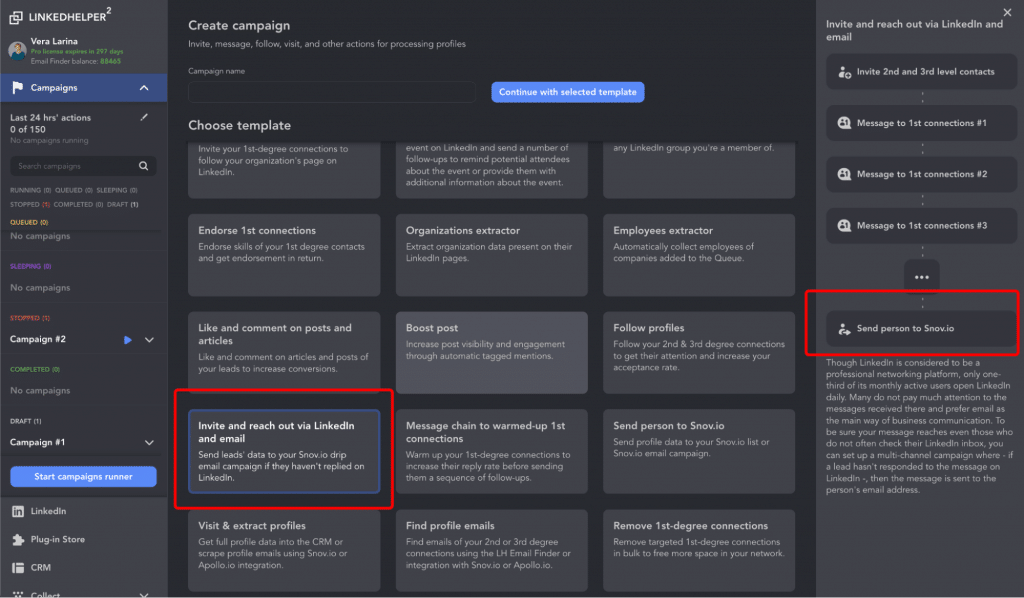
One touchpoint isn’t enough. Mix LinkedIn, email, and phone into a coherent sequence. Example:
Day 1 – LinkedIn connect → Day 3 – LinkedIn message → If no reply → Day 5 – Email → Day 8 – Call
Multi-channel = more visibility and better conversion.
3. Hyper-Personalization at Scale

Use context from the prospect’s LinkedIn activity (posts, company changes, common connections) to personalize your message.
The more relevant your message, the higher your reply rate.
4. Using Linked Helper for Automated LinkedIn Outreach
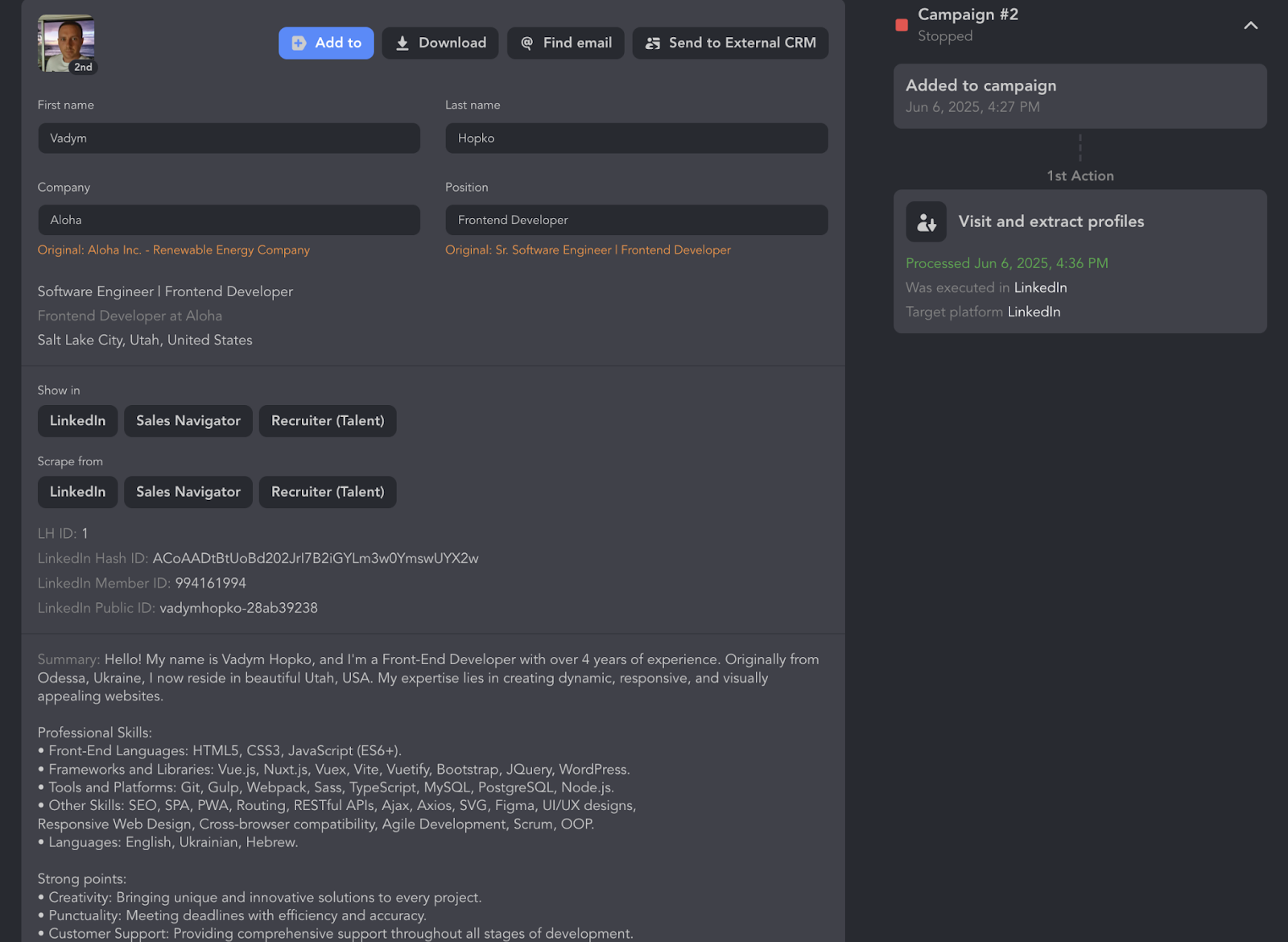
Stop manually visiting profiles and copying messages. Linked Helper automates:
- Profile visits
- Connection requests
- Smart follow-up messages
- Lead tagging in a built-in CRM
Spend less time clicking and more time closing.
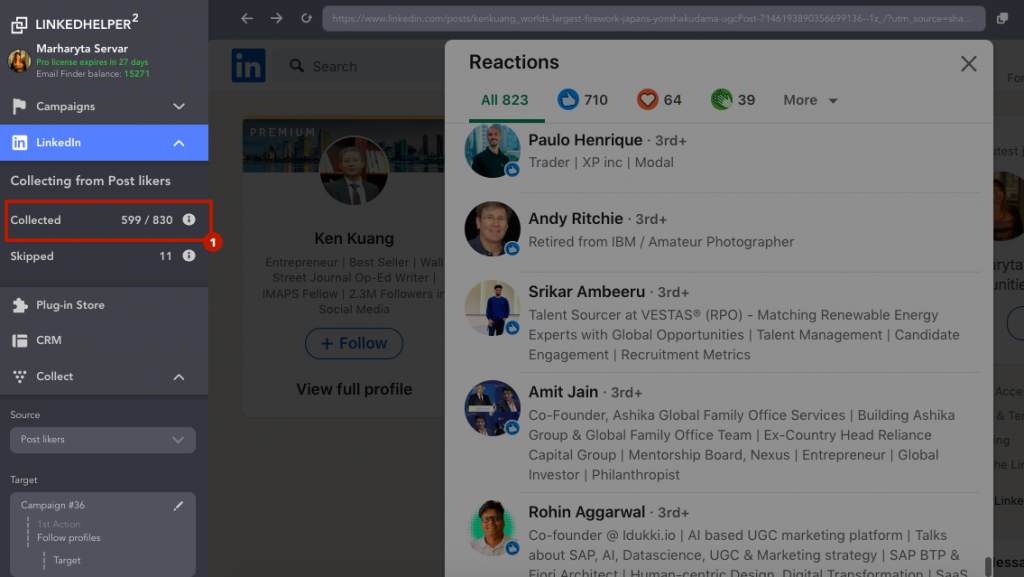
Use behavior-based workflows (e.g. auto-message after profile view) to simulate human behavior at scale.
5. AI-Powered Lead Scoring & Predictive Analytics

Use predictive analytics and AI to prioritize accounts most likely to convert. Focus your energy where ROI is highest.
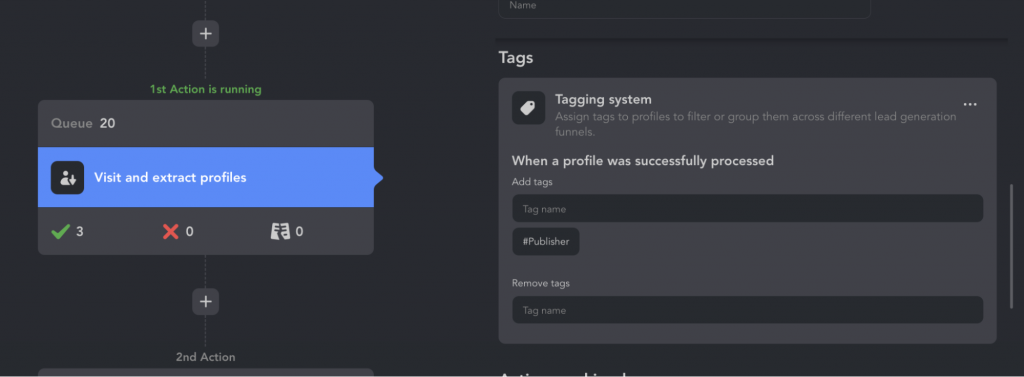
Leverage AI tools that analyze historical data to predict which leads are most likely to convert. This allows your team to prioritize their efforts on the most promising leads, a cornerstone of a modern b2b software sales strategy. Learn more about leveraging LinkedIn for B2B marketing with advanced analytics.
6. Social Selling via LinkedIn
Before you message — engage. Like posts, comment meaningfully, publish value-driven content.

Linked Helper Tip: Automate profile visits + warm-up actions like auto-follow or post likes to stay visible.
Before launching a campaign, it’s wise to consider the 12 things to ask yourself before you start your LinkedIn outreach.
7. Value-Based Selling and Consultative Approach
Focus on outcomes, not features. Use discovery calls to uncover the prospect’s deeper challenges, and tie your solution directly to their goals.
Sell transformation, not tech. This kind of LinkedIn outreach builds trust.
8. Account-Based Marketing (ABM) for Big Wins
Instead of casting a wide net, focus your sales and marketing efforts on a select group of high-value accounts. This allows for extreme personalization and has proven highly effective, with some agencies successfully scaling their ABM campaigns using automated workflows.
High-effort, high-reward. Especially for enterprise deals.
9. Lead Nurturing with Sequences and Follow-Ups
Instead of targeting 500 random leads, focus on 20 dream accounts and personalize everything. Coordinate sales and marketing touchpoints. One case study shows how a professional used automated sequences to create a predictable lead flow.
Consistency builds trust. Automation makes it sustainable.
10. Leveraging Video in Sales Emails
Add a human face to your message. Record a 60-second Loom video explaining how you can help.
Boosts reply rates and builds immediate trust.
11. Building Repeat Business and Upselling
Keep a clear process for follow-ups post-sale. Train CSMs and AEs to spot upsell/cross-sell opportunities and add value over time.
Retention and expansion are cheaper than new acquisition.
12. Empowering Reps with Sales Enablement Content
Arm your team with ready-to-send resources:
- Case studies
- ROI calculators
- Objection handling scripts
Less time creating, more time selling.
13. Continuous A/B Testing on Messaging
Test different variations of:
- Subject lines
- Opening hooks
- CTAs
Track what works, then scale it.

14. Feedback Loops from Closed-Lost Deals
Even the best reps need sharpening. Schedule regular:
- Call reviews
- Role-playing
- Feedback sessions
Use this data to evolve your outreach and positioning strategy.
15. Sales Coaching and Rep Optimization
Even the best reps need sharpening. Schedule regular:
- Call reviews
- Role-playing
- Feedback sessions
Skills training + mindset = sustainable performance.
Using Linked Helper to Power Your B2B Sales Strategy
While a solid strategy is the blueprint, execution is everything. This is where a powerful automation tool becomes a force multiplier for your sales team. Linked Helper is designed specifically to support and automate the most critical components of a modern B2B sales strategy, turning LinkedIn into a predictable source of qualified leads.
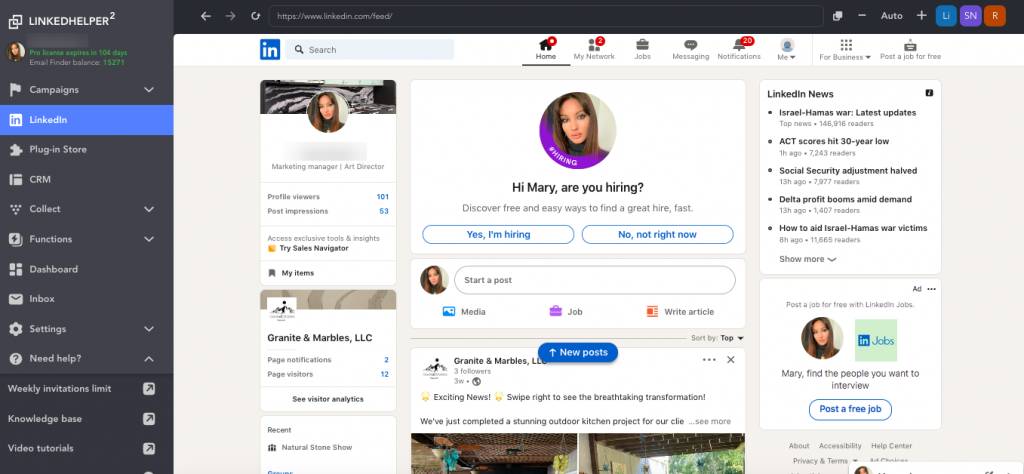
Instead of spending hours manually visiting profiles, sending connection requests, and following up, your reps can invest their energy where it matters: building relationships with engaged, high-potential prospects.
- Save Hundreds of Hours of Manual Work. Your sales reps should be relationship builders, not button clickers. Linked Helper automates top-of-funnel tasks, allowing teams to redirect their time toward qualified opportunities.
- Increase Engagement and Response Rates. With personalized outreach that mimics human behavior, campaigns feel authentic and timely leading to higher connection and reply rates.
- Drive More Revenue, Consistently. Automated, repeatable workflows allow you to scale your outreach without scaling headcount.
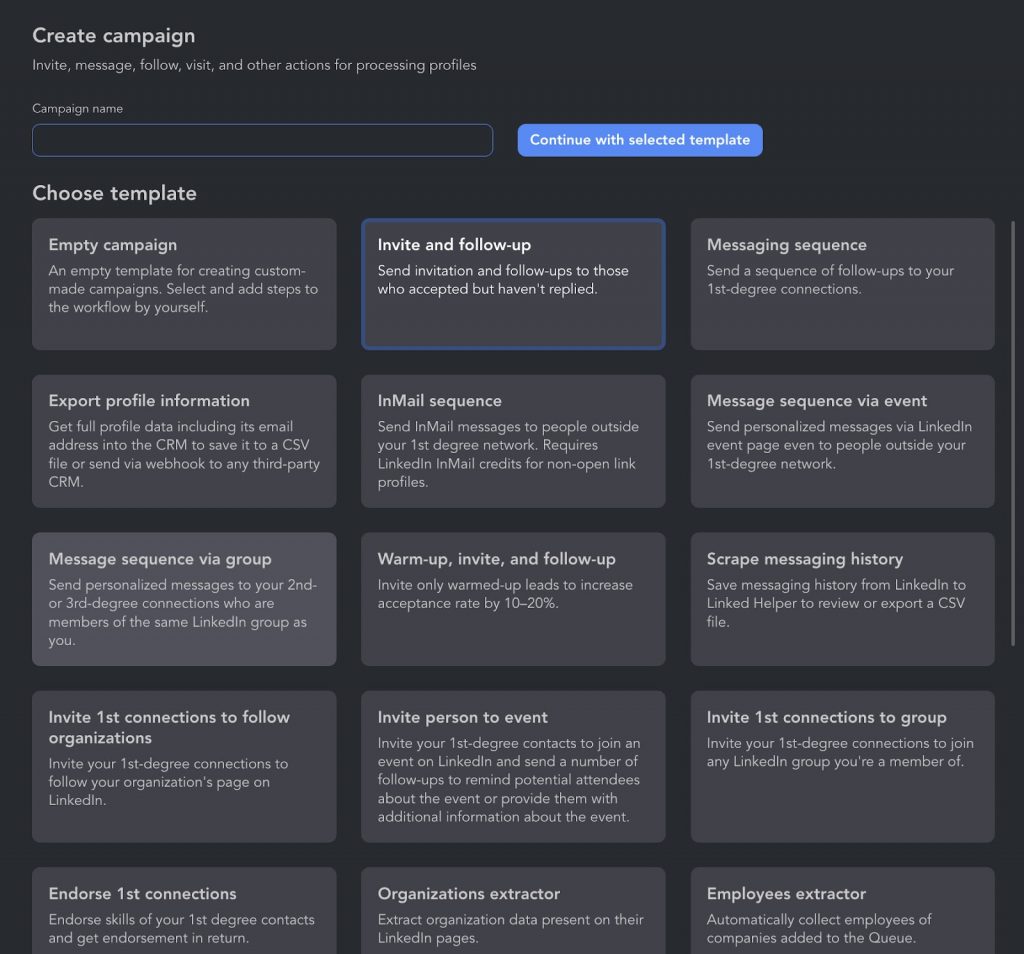
Real-World Impact:
- Trade Tribe Agency used Linked Helper to automate their client acquisition process, resulting in 60+ qualified meetings per month. They also cut out expensive SaaS overheads, boosting margins while scaling faster.
- Hugh Lorch (LinkedIn 15X) slashed his manual outreach time from 40 hours a week to just two. This 90% reduction in time allowed him to 2-3x the number of qualified leads he generated, with one client securing $118,000 in revenue in just 45 days from the campaigns he implemented.
Here’s what makes Linked Helper a critical part of a modern B2B sales stack:
- Drip Campaigns & If-Then Logic:
Create advanced workflows like:
Follow or Like recent post → Wait 1 day → Send personalized connect request → Wait for acceptance → Send Message #1 → Wait → Message #2…
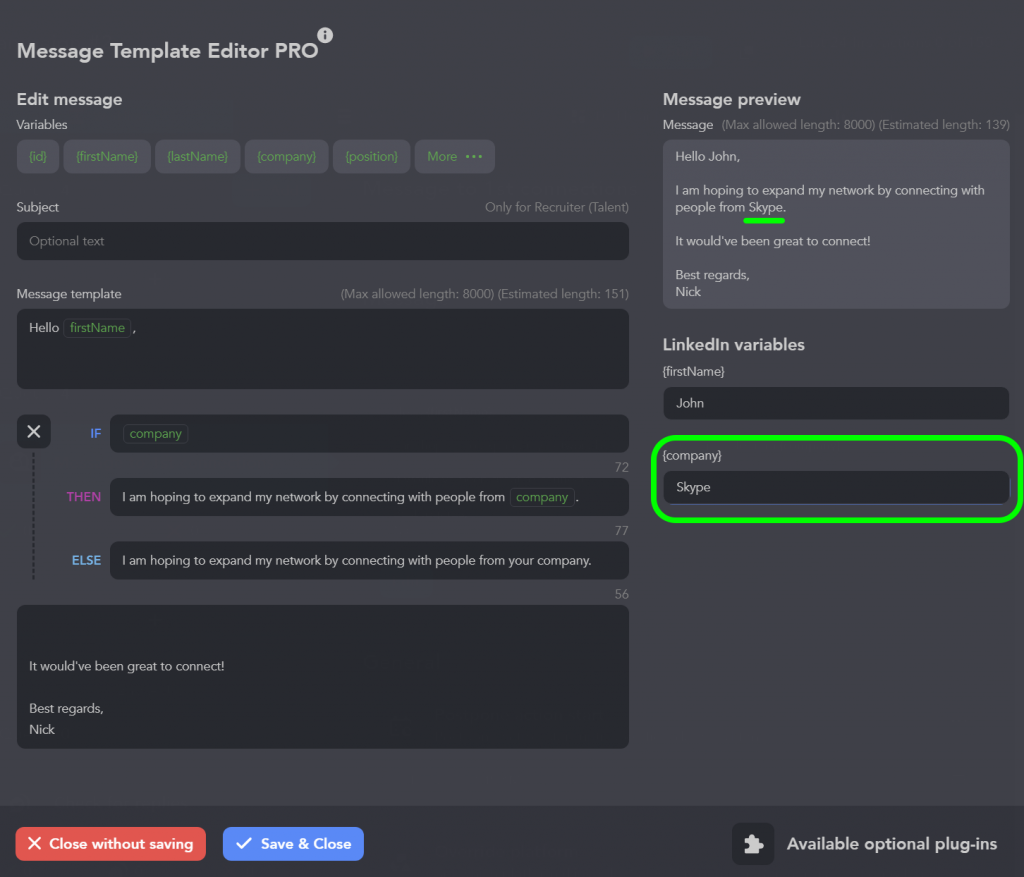
Each step is triggered by specific actions and behavior, and sequences automatically stop if a prospect replies—just like a human would.
- Action Sequence Builders
Go beyond basic messaging. Set up automated sequences that:
- Like recent posts
- Endorse skills
- Send a follow-up
- Tag prospects for later nurturing
It’s automation that feels human—at scale.
- Safety and Compliance
Unlike risky cloud-based bots, Linked Helper runs locally on your machine, mimicking browser behavior and staying under LinkedIn’s radar. With built-in activity limits, timing randomization, and campaign pausing, your account stays protected while operating at full capacity.
- CRM Integration

Automatically sync leads, tags, and message history to your CRM using webhooks—keeping your pipeline organized and your team in sync without extra manual work.
Mistakes to Avoid When Building Your B2B Sales Strategy
Even with a rock-solid plan, your B2B sales strategy can fall apart if you repeat common mistakes that plague even experienced teams. Avoiding these pitfalls is just as important as executing your tactics. Here are the most critical missteps—and how to fix them:

- Automation is a tool—not a substitute for real conversations.
While automation tools like Linked Helper are powerful for scaling top-of-funnel outreach, they should never replace authentic, relationship-building engagement.
Fix: Use automation to initiate conversations—visiting profiles, sending requests, and delivering follow-ups. But as soon as a prospect engages, hand it off to a human sales rep to build trust and close the deal.
- One-size-fits-all messaging fits no one.
Sending the same outreach message to a CEO, CMO, and Head of Sales is a guaranteed way to be ignored. Their goals, pain points, and decision-making processes are entirely different.
Fix: Use the segmentation from your Ideal Customer Profile (ICP) to create persona-specific templates. Tailor your outreach by role, industry, and buying stage.
- You can’t sell effectively if you don’t know who you’re targeting.
If your buyer profile is vague—or worse, based on assumptions—your messaging, targeting, and sales funnel will be misaligned from day one.
Fix: Revisit Step 1 of your strategy. Build a data-backed, behavior-informed ICP that includes firmographics, technographics, economic potential, and behavioral triggers. Leverage insights from your CRM and LinkedIn activity for real-time adjustments.
- Losing a deal without learning why is a wasted opportunity.
Many teams move on too quickly when a deal is lost, missing out on invaluable insights that could improve both messaging and product-market fit.
Fix: Conduct “closed-lost” interviews or send short surveys to understand the reasons behind the loss. Was it price, timing, missing features, or unclear value? Then, share those insights with both your sales and product/marketing teams.
- You can’t optimize what you don’t measure.
If your team isn’t consistently tracking key sales metrics, your strategy is running on guesswork, not data.
Fix: Set up a centralized dashboard to track core KPIs like:
- Connection-to-meeting conversion rates
- Reply rates per sequence or channel
- Pipeline velocity
- Win/loss ratios
Review these metrics weekly and refine your approach based on performance trends.
- Features don’t sell—outcomes do.
Too many teams lead with what their product does rather than what it delivers. If your messaging doesn’t clearly articulate business impact, prospects will tune out.
Fix: Collaborate with marketing to craft a clear, ROI-driven value proposition. Focus on tangible business outcomes—such as time saved, revenue gained, or risk reduced. Train your entire sales team to lead with this value, not a list of specs.
Avoiding these mistakes will put you ahead of most competitors who are still struggling with misaligned messaging, weak data, or over-reliance on automation. Combine strong strategy with disciplined execution, and your B2B sales engine will deliver predictable, scalable growth.
B2B Sales Strategy FAQs
What is the rule of 7 in B2B?
The “Rule of 7” is a classic marketing principle suggesting that a prospect needs to see or hear your message at least seven times before they take action. In modern B2B sales, this translates to a multi-channel, multi-touch strategy involving a mix of profile views, content engagement, emails, and LinkedIn messages to build recognition and trust.
What are the 7 steps of the B2B selling process?
While models vary, a typical 7-step B2B selling process includes:
1) Preparation and Research,
2) Prospecting,
3) Needs Assessment (Discovery Call),
4) Value Proposition (Pitch/Demo),
5) Handling Objections,
6) Closing the Deal, and
7) Follow-up and Relationship Management.
How to be successful at B2B sales?
Success in B2B sales today hinges on three things: a deep understanding of your customer’s business, a value-based and consultative approach, and the intelligent use of technology to create personalized interactions at scale. Building long-term relationships is more important than making a quick sale.
How to dominate in B2B sales?
Dominating in B2B sales requires moving beyond just having a good product. It requires building a superior sales and marketing strategy for B2B SaaS (or your specific industry), creating a powerful brand presence, empowering your team with the best tools and training, and relentlessly optimizing every stage of your sales funnel based on data.
What are the best B2B sales strategies?
The best B2B sales strategies are customer-centric, data-driven, and adaptable. Account-Based Marketing (ABM), Social Selling on LinkedIn, and Value-Based Selling are consistently ranked among the most effective. However, the absolute best strategy is one that is tailored to your specific product, market, and ideal buyer personas.